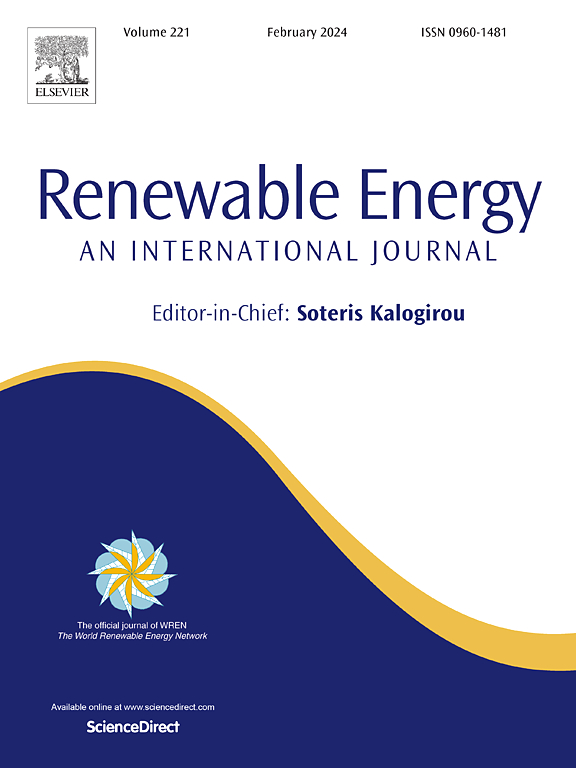Multi-objective optimization of hydraulic performance of an ultra-low head axial-flow turbine with improved blade camber line configuration
IF 9
1区 工程技术
Q1 ENERGY & FUELS
引用次数: 0
Abstract
Against the backdrop of the progressive and comprehensive development of large-scale hydroelectric facilities, there remains a considerable number of untapped low-head river segments in rural, remote, and hilly areas. Low-head hydropower technology, renowned for its versatility and minimal environmental impact, is the optimal power generation solution for such areas. This technology's high potential and efficiency underscore its crucial role in developing small, low-head hydropower systems. This paper introduces a camber line configuration method that utilizes two segments of second-order Bézier curves based on a fish-friendly ultra-low head axial flow turbine model developed using standard modular hydropower technology. The method accurately describes and controls the maximum camber position of the airfoil during the optimization process, allowing for a decoupling of the blade camber line placement angle and the maximum camber in the airfoil design. Based on the enhanced bone-line design method, optimization is conducted with the specific goal of improving the hydraulic efficiency and output power of the hydraulic turbine. As a result, a remarkable efficiency improvement of 2.79 % and a substantial output power enhancement of 5.93 % were successfully attained, respectively. The analysis indicates that the enhanced bone-line design enables a closer alignment of the fluid flow within the turbine with the desired ideal flow pattern. Consequently, it effectively diminishes internal entropy production losses, improves the pressure distribution on the blades, and ultimately achieves a significant enhancement in turbine performance. These research findings provide valuable insights and references for the bone-line configuration in optimizing the hydraulic design of ultra-low head hydraulic turbines.
超低水头轴流式水轮机改进叶型线结构水力性能多目标优化
在大规模水电设施逐步全面发展的背景下,农村、偏远地区和丘陵地区仍有相当数量的低水头河段尚未开发。低水头水力发电技术以其通用性和对环境影响最小而闻名,是这些地区的最佳发电解决方案。该技术的高潜力和高效率突出了其在开发小型、低水头水电系统中的关键作用。本文介绍了一种基于标准模块化水电技术开发的对鱼友好的超低水头轴流式水轮机模型,利用两段二阶bsamzier曲线的弧线配置方法。该方法准确地描述和控制翼型在优化过程中的最大弧度位置,允许叶片弧度线放置角和最大弧度在翼型设计的解耦。基于增强骨线设计方法,以提高水轮机的水力效率和输出功率为具体目标进行优化。结果,效率提高了2.79%,输出功率提高了5.93%。分析表明,增强的骨线设计使涡轮内的流体流动更接近理想的流型。因此,它有效地减少了内部熵产损失,改善了叶片上的压力分布,最终实现了涡轮性能的显著提高。这些研究结果为超低水头水轮机水力优化设计的骨线配置提供了有价值的见解和参考。
本文章由计算机程序翻译,如有差异,请以英文原文为准。
求助全文
约1分钟内获得全文
求助全文
来源期刊

Renewable Energy
工程技术-能源与燃料
CiteScore
18.40
自引率
9.20%
发文量
1955
审稿时长
6.6 months
期刊介绍:
Renewable Energy journal is dedicated to advancing knowledge and disseminating insights on various topics and technologies within renewable energy systems and components. Our mission is to support researchers, engineers, economists, manufacturers, NGOs, associations, and societies in staying updated on new developments in their respective fields and applying alternative energy solutions to current practices.
As an international, multidisciplinary journal in renewable energy engineering and research, we strive to be a premier peer-reviewed platform and a trusted source of original research and reviews in the field of renewable energy. Join us in our endeavor to drive innovation and progress in sustainable energy solutions.
 求助内容:
求助内容: 应助结果提醒方式:
应助结果提醒方式:


